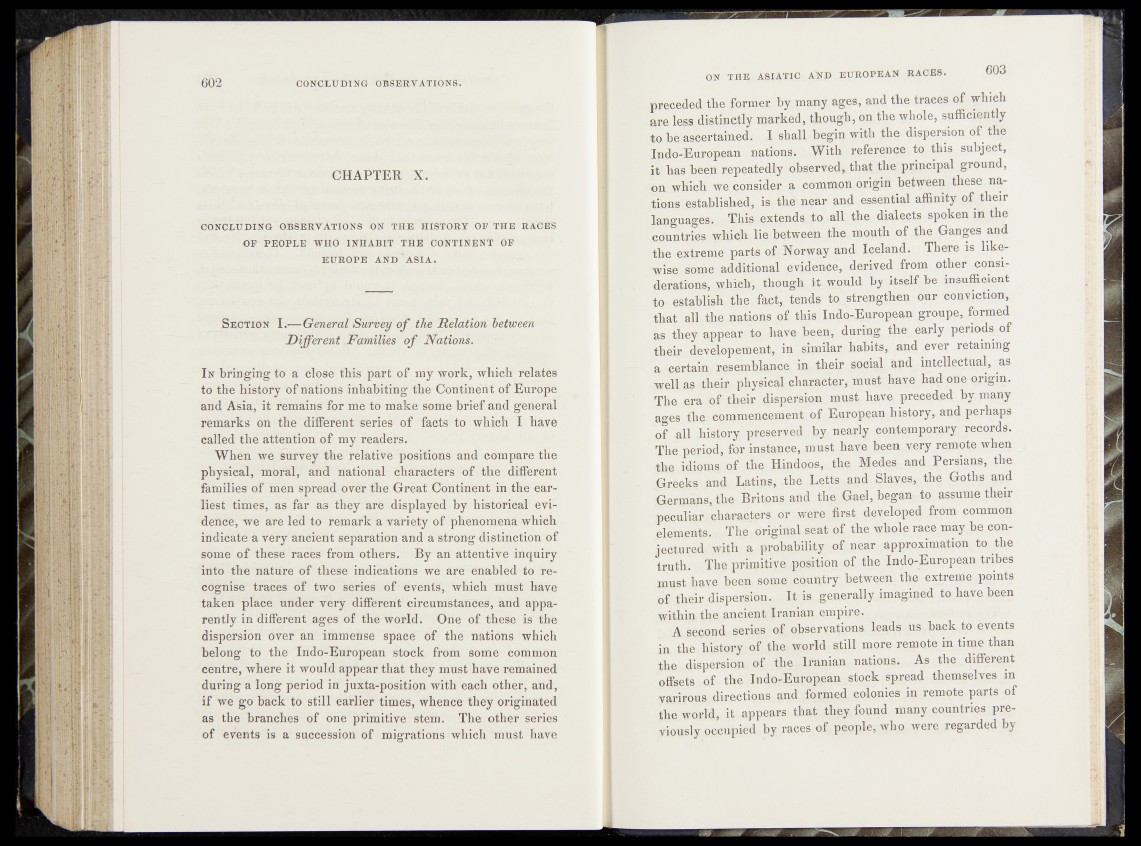
602 CONCLUDING OBSERVATIONS.
CHAPTER X.
CONCLUDING OBSERVATIONS ON THE HISTORY OF THE RACES
OF PEOPLE WHO INHABIT THE * fedlTTl'NENT OF ,
EUROPE AND'ASIA.
__ S e c t io n I .—General Survey of the Relation between
Different Families of Nations.
I n bringing to a close this part of my work, which relates
to the history of nations inhabiting the Continent of Europe
and Asia, it remains for me to make some brief and general
remarks on the different series of facts to which I have
called the attention of my readers.
When we survey the relative positions and compare the
physical, moral, and national characters of the different
families oFlhen spread over the Great Continent in the earliest
times, as far as they are displayed by historical evidence,
we are led to remark a variety of phenomena which
indicate a very ancient separation and a strong distinction of
some of these races from others. By an attentive inquiry
into the nature of these indications we are enabled' to recognise
traces of two series of events, which must have
taken place under very different circumstances, and apparently
in different ages of the world. One of these is the
dispersion over an immense space of the nations which
belong to the Indo-European stock from some common
centre, where it would appear that they must have remained
during a long period in juxta-position with each other, and,
if we go back to still earlier times, whence they originated
as the branches of one primitive stem. The other series
of events is a succession of migrations which must have
.preceded the former by many ages, and the traees of which
are less distinctly marked, though, on the whole, sufficiently
to be ascertained. I.shall begin with the dispersion of the
Indo-European nations. With reference to this subject,
it has been repeatedly . observed,, that the principal ground,
on which wqepnsider a common origin between these nations
established, is thd near and essential affinity of their
languages. This extends to all the, dialects spoken in the
countries whicktlie between the mouth of,the Ganges and
the extreme parts of Norway and. Iceland. There M likewise
some additional evidence, derived from other considerations,
which, though it would by itself be insufficient
to establish; the fact, tends to strengthen our conviction,
that all the nations of, Jp^Enropean groppe, formed
as they appear to havq bf§n, duriqgthe, early periods of
their developement, in similar habits, and ever ..retaining
a certain^ reseppbl§pce in their social and intellectual, as
well as /their physical,character, must have, had one origin.
The era of their ^jspersiop mUst have preceded by many
ages the commencement of European histpry, and perhaps
of 0 history preserved^y nearly, contemporary records.
The period, for instance, must have ^eept very .remote when
the idioms of the Hindoos, the Medes and Persians, the
„Greeks and Latins, the Letts and Slaves,vthp ,Gothf and
GermanSt fhe Britons and the Gael, begap{ to assume their
peculiar characters or were .first* developed from common
elements... The. original seat of the whole race may be C9-PT
jectured with a probability of near approximation to the
truth. The primitive position of the Indo-European, tfjbes
must have beep, some country between the extreme ^points
of their dispersion. It is generally imagined tq have been
within the ancient Iranian empire. . ; ;
A seppnd series of observations leads us back tpscyenfs
in the history of the, world still more remote in tinie than
the dispersion|of the Iranian nations.,v As the different
offsets of the» Indo-European stocli spread themselves. in
varirous, directions,- and formed^ colonije| in remote parts of
the world, it appears that tlipy found many countries previously
occupied by races of people, who were regarded by